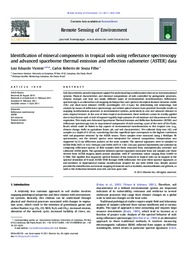Identification of mineral components in tropical soils using reflectance spectroscopy and advanced spaceborne thermal emission and reflection radiometer (ASTER) data.
Identification of mineral components in tropical soils using reflectance spectroscopy and advanced spaceborne thermal emission and reflection radiometer (ASTER) data.
Author(s): VICENTE, L. E.; SOUZA FILHO, C. R. de
Summary: Soil characteristics provide important support for understanding transformations that occur in environmental systems. Physical characteristics and chemical compositions of soils controlled by pedogenetic processes, climatic changes and land use imply different types of environmental transformations. Reflectance spectroscopy is an alternative soil mapping technique that uses spectral absorption features between visible (VIS) and short-wave infrared (SWIR) wavelengths (0.3?2.5 μm) for determining soil mineralogy. Soil analysis by means of reflectance spectroscopy and orbital optical sensors have provided favorable results in mapping transformation processes in environmental systems, particularly in arid and semiarid climates in extra-tropical terrains. In the case of inter-tropical environments, these methods cannot be readily applied due to local factors such as lack of exposed regolith, high amounts of soil moisture and the presence of dense vegetation. This study uses Advanced Spaceborne Thermal Emission and Reflection Radiometer (ASTER) and reflectance spectroscopy data to map mineral components of soils covering a part of the state of São Paulo, Brazil, which could be linked to key aspects of environmental transformations in this tropical area (e.g., climate change, shifts in agriculture fronts, ph, and soil characteristics). We collected forty-two (42) soil samples at a depth of 0?20 cm, considering that this superficial layer corresponds to the highest correlation with soil properties detected by the ASTER sensor. These samples were measured using a FieldSpec FR spectrometer, and the derived spectra were interpreted for mineral composition. Interpretation was supported by X-ray diffraction analysis on the same samples. The spectral signatures were re-sampled to ASTER VNIR (AST1-4: 0.52?0.86 μm) and SWIR (AST5-9: 1.60?2.43 μm) spectral bandwidths and validated by comparing reflectance spectra of field samples with those extracted from atmospherically corrected and calibrated ASTER pixels. The agreement between spectral signatures measured from soil samples and those derived from ASTER imagery pixels proved plausible, with R2 correlation values ranging from 0.6493 to 0.7886. This signifies that diagnostic spectral features of key minerals in tropical soils can be mapped at the spectral resolution of 9-band ASTER VNIR through SWIR reflectance. We used these spectral signatures as end-members in hyperspectral routine classifications adapted for use with ASTER data. Results proved possible the identification and remote mapping of minerals such as kaolinite, montmorillonite and gibbsite, as well as the distinction between iron-rich and iron-poor soils.
Publication year: 2011
Types of publication: Journal article
Unit: Embrapa Territorial
Keywords: ASTER, Hyperspectral, Tropical terrains, reflectance spectroscopy, soil minerals
Observation
Some of Embrapa's publications are published as ePub files. To read them, use or download one of the following free software options to your computer or mobile device. Android: Google Play Books; IOS: iBooks; Windows and Linux: Calibre.
Access other publications
Access the Agricultural Research Database (BDPA) to consult Embrapa's full library collection and records.
Visit Embrapa Bookstore to purchase books and other publications sold by Embrapa.

